Comparison of AHP and a Utility-Based Theory Method for Selected Vertical and Horizontal Forest Structure Indicators in the Sustainability Assessment of Forest Management in the Sierra de Guadarrama National Park, Madrid Region
Abstract
1. Introduction
2. Material and Methods
2.1. Study Area
- “Type 1: Uneven-aged forest (multi-layered canopy) with very high crown cover. Area: 26 ha.
- Type 2: Multi-diameter forest with high crown cover. Area: 24 ha.
- Type 3: Multi-diameter forest with medium crown cover. Area: 29 ha.
- Type 4: Even-aged forest (single-story) with low crown cover. Area: 37 ha.
- Type 5: Zones with scarce tree cover. Area: 11 ha.”
2.2. Identifying the Alternatives
2.3. Utility Theory Based Method
- ;
2.4. AHP Method
- aij > 0, for all i, j
- aij = 1, if there is indifference in the preference between elements i and j and aii = 1 for each i;
- aji = 1/aij for each i, j.
- Xi is the integrated preference of alternative i.
- Wj is the weight obtained for criteria j.
- Xij is the preference of alternative i for criteria j.
2.5. Transitivity of the Preference
2.6. Preference Scoring
- In the first meeting, students with an inconsistency of over 0.1 in the AHP method revised their preference matrices to reduce this inconsistency.
- In the second meeting, they were presented with the results and asked their opinion of them and of the methods used.
2.7. Quantifying the Differences in Results between Both Methods
3. Results
4. Discussion
5. Conclusions
Author Contributions
Funding
Acknowledgments
Conflicts of Interest
References
- United Nations. Earth Summit Agenda 21, The United Nations Program of Action from Rio; United Nations: Bali, Indonesia, 1992; Available online: https://sustainabledevelopment.un.org/content/dsd/agenda21/index.shtml (accessed on 12 October 2018).
- CPFE. Resolution H1 General Guidelines for the Sustainable Management of Forests in Europe. In Proceedings of the Second Ministerial Conference on the Protection of Forests in Europe, Helsinki, Finland, June 1993; Available online: https://foresteurope.org/ministerial-conferencies/ (accessed on 12 October 2018).
- Montréal Process Working Group. Montréal Process Criteria and Indicators for the Conservation and Sustainable Management of Temperate and Boreal Forests. Technical Notes on Implementation of the Montréal Process Criteria and Indicators Criteria. 2009, pp. 1–7. Available online: https://www.montrealprocess.org/documents/publications/general/2009/2009p_4.pdf (accessed on 13 September 2018).
- Linser, S.; Wolfslehner, B.; Asmar, F.; Bridge, S.R.J.; Gritten, D.; Guadalupe, V.; Jafari, M.; Johnson, S.; Laclau, P.; Robertson, G. 25 Years of Criteria and Indicators for Sustainable Forest Management: Why Some Intergovernmental C&I Processes Flourished While Others Faded. Forests 2018, 9, 515. [Google Scholar] [CrossRef]
- Linser, S.; Wolfslehner, B.; Bridge, S.R.J.; Gritten, D.; Johnson, S.; Payn, T.; Prins, K.; Raši, R.; Robertson, G. 25 Years of Criteria and Indicators for Sustainable Forest Management: How Intergovernmental C&I Processes Have Made a Difference. Forests 2018, 9, 578. [Google Scholar] [CrossRef]
- Kates, R.W.; Clark, W.C.; Corell, R.; Hall, M.J.; Jaeger, C.C.; Lowe, I.; McCarthy, J.J.; Schellnhuber, H.J.; Bolin, B.; Dickson, N.M. Sustainability science. Science 2001, 292, 641–642. [Google Scholar] [CrossRef] [PubMed]
- Zijp, M.C.; Heijungs, R.; Van der Voet, E.; Van de Meent, D.; Huijbreggrs, M.; Hollander, A.; Posthuma, L. An identification key for selecting methods for sustainability assessment. Sustainability 2015, 7, 490–512. [Google Scholar] [CrossRef]
- Ness, B.; Urbel-Piirsalu, E.; Anderberg, S.; Olsson, L. Categorising tools for sustainability assessment. Ecol. Econ. 2007, 60, 498–508. [Google Scholar] [CrossRef]
- Reynolds, K.M.; Thomson, A.J.; Köhl, M.; Shannon, M.A.; Ray, D.; Rennolls, K. Sustainable Forestry from Monitoring and Modelling to Knowledge Management & Policy Science; CAB International: Wallingford, UK, 2007; p. 527. [Google Scholar]
- Forest Europe; UNECE; FAO. State of Europe’s Forests 2011: Status and Trends in Sustainable Forest Management in Europe; Forest Europe Liaison Unit: Oslo, Norway, 2011; ISBN 978-82-92980-05-7. [Google Scholar]
- UNECE; FAO. Pilot Project on the System for the Evaluation of the Management of Forests (SEMAFOR); United Nations: Geneva, Switzerland, 2017; p. 167. ISBN 978-92-1-117123-5. [Google Scholar]
- Appelstrand, M. Participation and societal values: The challenge for lawmakers and policy practitioners. For. Policy Econ. 2002, 4, 281–290. [Google Scholar] [CrossRef]
- FAO-ECE-ILO. Public Participation in Forestry in Europe and North America: Report of the FAO/ECE/ILO 163; International Labor Organization: Geneva, Switzerland, 2000; p. 119. [Google Scholar]
- Bruña-García, X.; Marey-Pérez, M.F. Public participation: A need of forest planning. iForest 2014, 7, 216–226. Available online: http://www.sisef.it/iforest/contents/?id=ifor0979-007 (accessed on 10 November 2018). [CrossRef]
- Bruña-García, X.; Marey-Pérez, M.F. El proceso de participación pública forestal en un contexto rural sin experiencia previa en participación. In Montes, Servicios y Desarrollo Rural, 6th Congreso Forestal Español; Sociedad Española de Ciencias Forestales: Vitoria Gasteiz, Spain, 2013; pp. 2–14. ISBN 978-84-937964-9-5. [Google Scholar]
- Bettelini, D.; Cantiani, M.G.; Mariotta, S. Experiences in participatory planning of designated areas: The Bavona Valley in Switzerland. Forestry 2000, 73, 187–198. [Google Scholar] [CrossRef]
- Renn, O.; Webler, T.; Wiedemann, P. Fairness and Competence in Citizen Participation: Evaluating Models for Environmental Discourse; Springer: New York, NY, USA, 1995; p. 367. ISBN 978-94-011-0131-8. [Google Scholar]
- Vidueira, P.; Díaz-Puente, J.M.; Afonso, A. The Worldwide Expansion of Evaluation: A World of Possibilities for Rural Development. Cuadernos de Desarrollo Rural 2013, 10, 159–180. [Google Scholar]
- Kangas, J.; Kangas, A. Multiple criteria decision support in forest management—The approach, methods applied, and experiences gained. For. Ecol. Manag. 2005, 207, 133–143. [Google Scholar] [CrossRef]
- Cantiani, M.G. Forest planning and public participation: A possible methodological approach. iForest 2012, 5, 72–82. Available online: http://www.sisef.it/iforest/contents/?id=10.3832/ifor0602-009 (accessed on 20 July 2018). [CrossRef]
- Linder, W.; Lanfranchi, P.; Schnyder, D.; Vatter, A. Procédures et Modèles deParticipation–Propositions pour une Politique de Participation de la Confédération Selon l’art. 4 LAT; Office Fédéral de l’Aménagement du Territoire, OCFIM: Berne, Switzerland, 1992; p. 130. [Google Scholar]
- Loikkanen, T.; Simojoki, T.; Wallenius, P.; Metsaehallitus, V. Participatory Approach to Natural Resource Management: A Guide Book; Finnish Forest and Park Service, Suomen Graafiset Pavelut Oy Ltd.: Kuopio, Finland, 1999; p. 96. ISBN 952-446-130-7. [Google Scholar]
- Vainikainen, N.; Kangas, A.; Kangas, J. Empirical study on voting power in participatory forest planning. J. Environ. Manag. 2008, 88, 173–180. [Google Scholar] [CrossRef] [PubMed]
- Stenseke, M. Local participation in cultural landscape maintenance: Lessons from Sweden. Land Use Policy 2009, 26, 214–223. [Google Scholar] [CrossRef]
- Abee, A. Application of criteria and indicators of sustainable resource management in the United States. In Sustainable Forestry from Monitoring and Modelling to Knowledge Management & Policy Science; Reynolds, K.M., Thomson, A.J., Köhl, M., Shannon, M.A., Ray, D., Rennolls, K., Eds.; CAB International: Wallingford, UK, 2007; pp. 75–102. ISBN 1845931742. [Google Scholar]
- Duffy, D.M.; Roseland, M.; Gunton, T.I. A preliminary assessment of shared decision-making in land use and natural resource planning. Environments 1996, 23, 1–16. Available online: https://search.proquest.com/docview/207672879?pq-origsite=gscholar (accessed on 13 September 2018).
- Forestry Commission. Summary Results of the 2003 UK Survey of Public Opinion of Forestry; Forestry Commission: Edinburgh, UK, 2003; p. 34. [Google Scholar]
- Hiltunen, V.; Kangas, J.; Pykäläinen, J. Voting methods in strategic forest planning—Experiences from Metsähallitus. For. Policy Econ. 2008, 10, 117–127. [Google Scholar] [CrossRef]
- Kouplevatskaya, I. Participation as a new mode of governance? Scientists and policymakers linked in a double spiral. In Sustainable Forestry from Monitoring and Modelling to Knowledge Management & Policy Science; Reynolds, K.M., Thomson, A.J., Köhl, M., Shannon, M.A., Ray, D., Rennolls, K., Eds.; CAB International: Wallingford, UK, 2007; pp. 35–56. ISBN 1845931742. [Google Scholar]
- Laukkanen, S.; Palander, T.; Kangas, J.; Kangas, A. Evaluation of the multicriteria approval method for timber-harvesting group decision support. Silva Fenn. 2005, 39, 249–264. [Google Scholar] [CrossRef]
- Sheppard, R.J.; Meitner, M. Using multi-criteria analysis and visualisation for sustainable forest management planning with stakeholder groups. For. Ecol. Manag. 2005, 207, 171–187. [Google Scholar] [CrossRef]
- Díaz-Balteiro, L.; Romero, C. Sustainability of forest management plans: A discrete goal programming approach. J. Environ. Manag. 2004, 71, 351–359. [Google Scholar] [CrossRef] [PubMed]
- Mendoza, G.A.; Prabhu, R. Qualitative multi-criteria approaches to assessing indicators of sustainable forest resource management. For. Ecol. Manag. 2003, 174, 107–126. [Google Scholar] [CrossRef]
- Mendoza, G.A.; Prabhu, R. Combining participatory modeling and multicriteria analysis for community-based management. For. Ecol. Manag. 2005, 207, 145–156. [Google Scholar] [CrossRef]
- Sugimura, K.; Howard, T.E. Incorporating social factors to improve the Japanese forest zoning process. For. Policy Econ. 2008, 10, 161–173. [Google Scholar] [CrossRef]
- Thomson, A.J. How should we manage knowledge ecosystems? Using additive knowledge management. In Sustainable Forestry from Monitoring and Modelling to Knowledge Management & Policy Science; Reynolds, K.M., Thomson, A.J., Köhl, M., Shannon, M.A., Ray, D., Rennolls, K., Eds.; CAB International: Wallingford, UK, 2007; pp. 461–480. ISBN 1845931742. [Google Scholar]
- Mustajoki, J.; Saarikoski, H.; Marttunen, M.; Ahtikoski, A.; Hallikainen, V.; Helle, T.; Hyppönen, M.; Jokinen, M.; Naskali, A.; Tuulentie, S.; et al. Use of decision analysis interviews to support the sustainable use of the forests in Finnish Upper Lapland. J. Environ. Manag. 2011, 92, 1550–1563. [Google Scholar] [CrossRef] [PubMed]
- Ocampo-Melgar, A.; Bautista, S.; de Steiguer, J.E.; Orr, B.J. Potential of an outranking multi-criteria approach to support the participatory assessment of land management actions. J. Environ. Manag. 2017, 195, 70–77. [Google Scholar] [CrossRef] [PubMed]
- Saaty, T.L. The Analytic Hierarchy Process; McGraw Hill: New York, NY, USA, 1980; p. 286. [Google Scholar]
- Esmail, B.A.; Geneletti, D. Multi-criteria decision analysis for nature conservation: A review of 20 years of applications. Methods Ecol. Evol. 2017, 42–53. [Google Scholar] [CrossRef]
- Díaz-Balteiro, L.; Romero, C. Making forestry decisions with multiple criteria: A review and an assessment. For. Ecol. Manag. 2008, 255, 3222–3241. [Google Scholar] [CrossRef]
- Fishburn, P.C. Interval Orders and Interval Graphs: A Study of Partially Ordered Sets; John Wiley: New York, NY, USA, 1985; p. 230. ISBN 978-0471812845. [Google Scholar]
- Martínez-Falero, J.E.; Ayuga-Tellez, E.; Gonzalez-Garcia, C.; Grande-Ortiz, M.A.; Sánchez De Medina, A. Experts’ Analysis of the Quality and Usability of SILVANET Software for Informing Sustainable Forest Management. Sustainability 2017, 9, 1200. [Google Scholar] [CrossRef]
- Martín-Fernández, S.; Martinez-Falero, E. Sustainability assessment in forest management based on individual preferences. J. Environ. Manag. 2018, 206, 482–489. [Google Scholar] [CrossRef] [PubMed]
- Martinez-Falero, E.; Martín-Fernández, S.; García-Abril, A. SILVANET: Participación Pública Para la Gestión Forestal Sostenible; Fundación Conde del Valle de Salazar: Madrid, Spain, 2010; p. 106. ISBN 978-84-96442-36-8. [Google Scholar]
- Pascual, C.; García-Abril, A.; GarcÍa-Montero, L.G.; Martín-Fernández, S.; Cohen, W.B. Object-based semi-automatic approach for forest structure characterization using lidar data in heterogeneous Pinus sylvestris stands. For. Ecol. Manag. 2008, 255, 3677–3685. [Google Scholar] [CrossRef]
- Zeleny, M. Multiple Criteria Decision Making; McGraw-Hill: New York, NY, USA, 1982; p. 563. ISBN 9780070727953. [Google Scholar]
- Zhiqiang, L.; Xue, Y.; Qiu, Z.; Xu, Z.; Zhang, X.; Zhou, B.; Wang, X. AHP-Ideal Point Model for Large Underground Petroleum Storage Site Selection: An Engineering Application. Sustainability 2017, 9, 2343. [Google Scholar] [CrossRef]
- Mahalanobis, P.C. On the Generalised Distance in Statistics; National Institute of Science of India: Brahmapur, India, 1936; Volume 2, pp. 49–55. [Google Scholar]
- Nishimura, H. The transitive core Inference of welfare from nontransitive preference relations. Theor. Econ. 2018, 13, 579–606. [Google Scholar] [CrossRef]
- Saaty, T.L. A scaling method for priorities in hierarchical structures. J. Math. Psychol. 1977, 15, 234–281. [Google Scholar] [CrossRef]
- Saaty, T.L. How to make a decision: The analytic hierarchy process. Interfaces 1994, 24, 19–43. [Google Scholar] [CrossRef]
- Davis, D.; Holt, C.A. Experimental Economics; Princeton University Press: Princeton, NJ, USA, 1993; p. 584. ISBN 9780691043173. [Google Scholar]
- Kil, S.-H.; Lee, D.K.; Kim, J.-H.; Li, M.-H.; Newman, G. Utilizing the Analytic Hierarchy Process to Establish Weighted Values for Evaluating the Stability of Slope Revegetation based on Hydroseeding Applications in South Korea. Sustainability 2016, 8, 58. [Google Scholar] [CrossRef]
- Armacost, R.L.; Componation, P.J.; Mullens, M.A.; Swart, W.W. An AHP framework for prioritizing customer requirements in QFD: An industrialized housing application. IIE Trans. 1994, 26, 72–79. [Google Scholar] [CrossRef]
- Mawapanga, M.N.; Debertin, D.L. Choosing between alternative farming systems: An application of the analytic hierarchy process. Rev. Agric. Econ. 1996, 18, 385–401. [Google Scholar] [CrossRef]
- Perini, A.; Ricca, F.; Susi, A. Tool-supported requirements prioritization: Comparing the AHP and CBrank methods. Inf. Softw. Technol. 2009, 51, 1021–1032. [Google Scholar] [CrossRef]
- Mau-Crimmins, T.; Steiguer, J.E.; Dennis, D. AHP as a means for improving public participation: A pre-post experiment with university students. For. Policy Econ. 2003, 7, 501–514. [Google Scholar] [CrossRef]
- Arroyo, P.; Tommelein, I.D.; Ballard, G. Comparing AHP and CBA as decision methods to resolve the choosing problem in detailed design. J. Constr. Eng. Manag. ASCE 2015, 141. [Google Scholar] [CrossRef]
- Saaty, T.L. Fundamentals of Decision Making and Priority Theory with the Analytic Hierarchy Process; RWS Publ.: Pittsburgh, PA, USA, 2006; ISBN 978-0962031762. [Google Scholar]
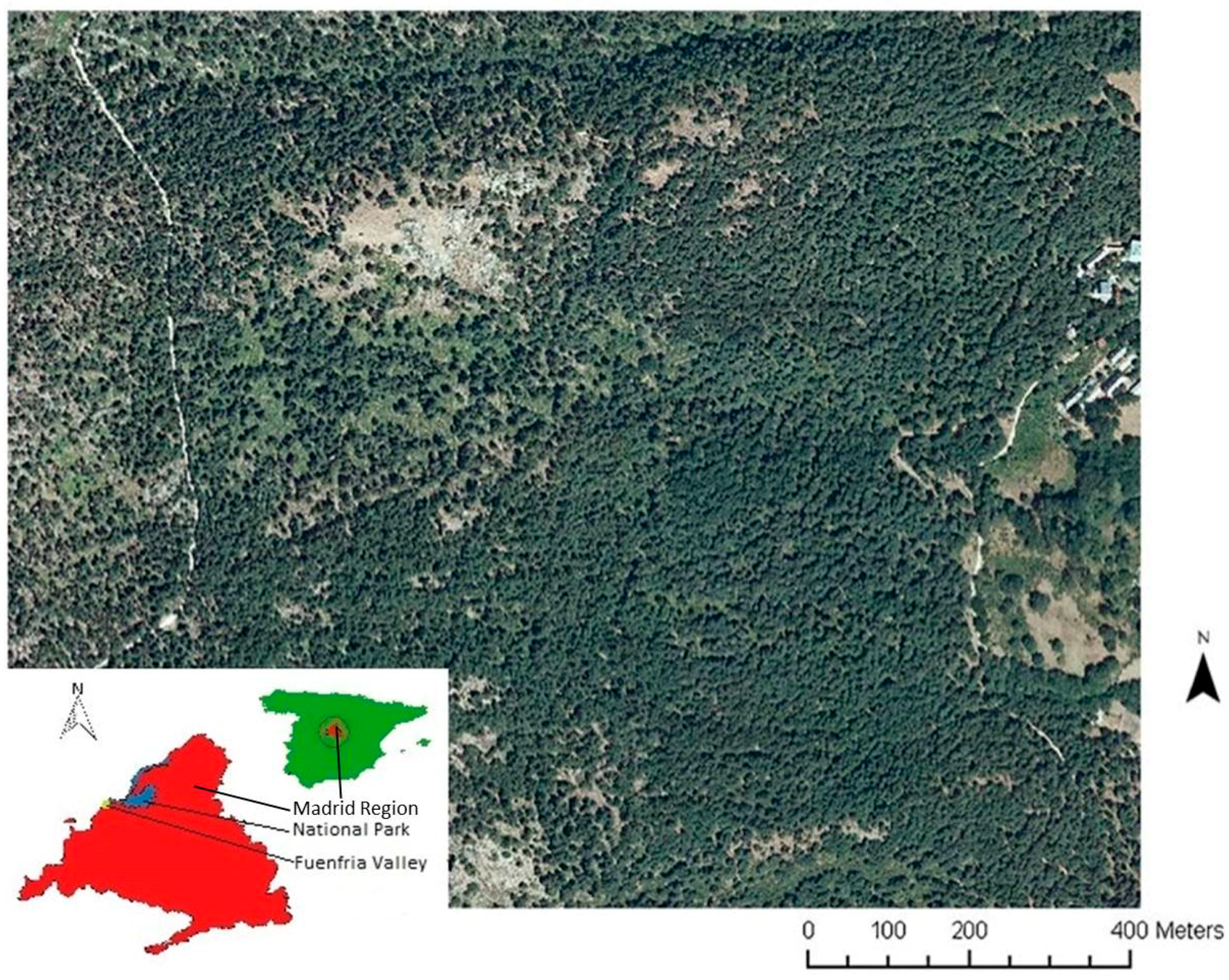
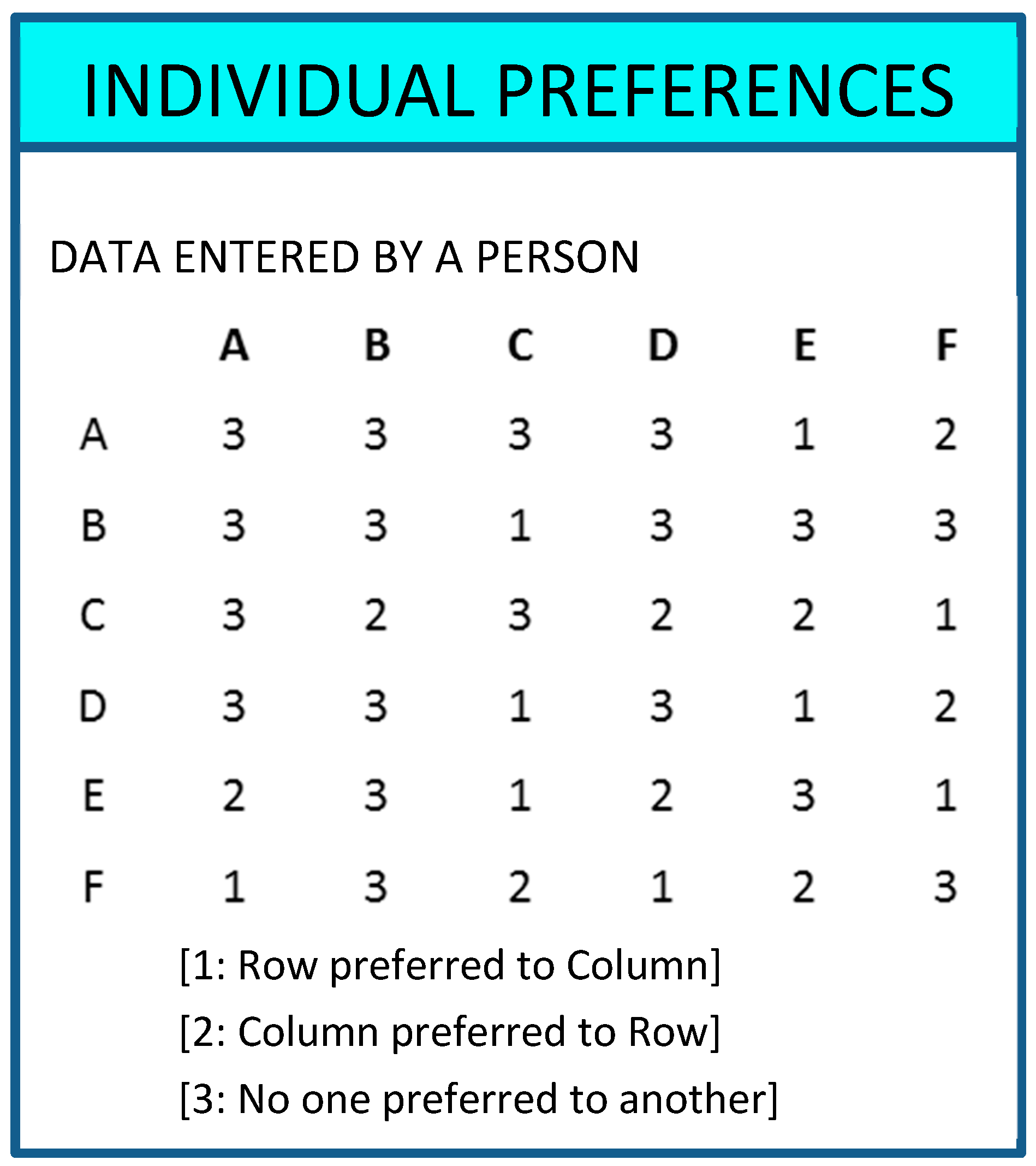
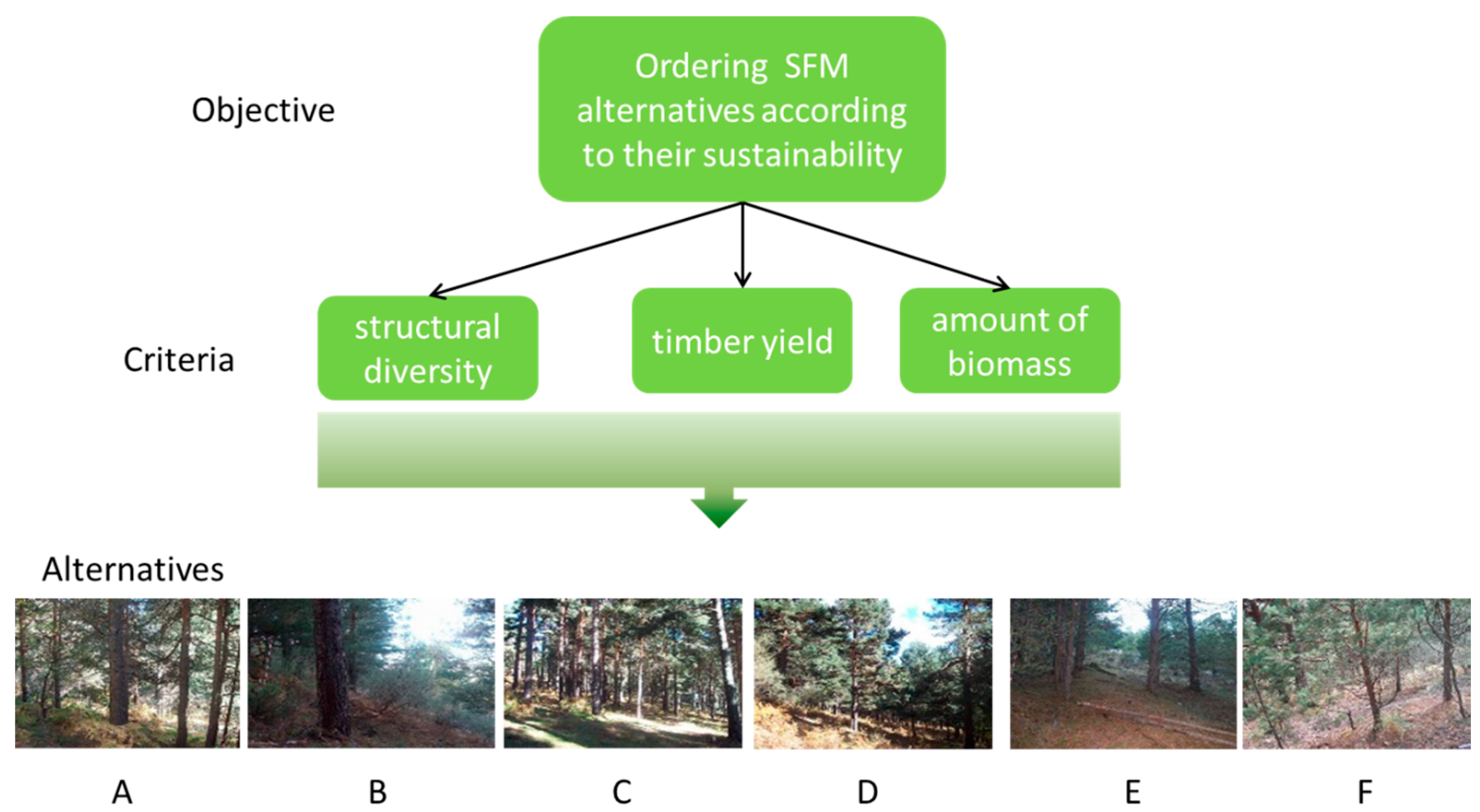
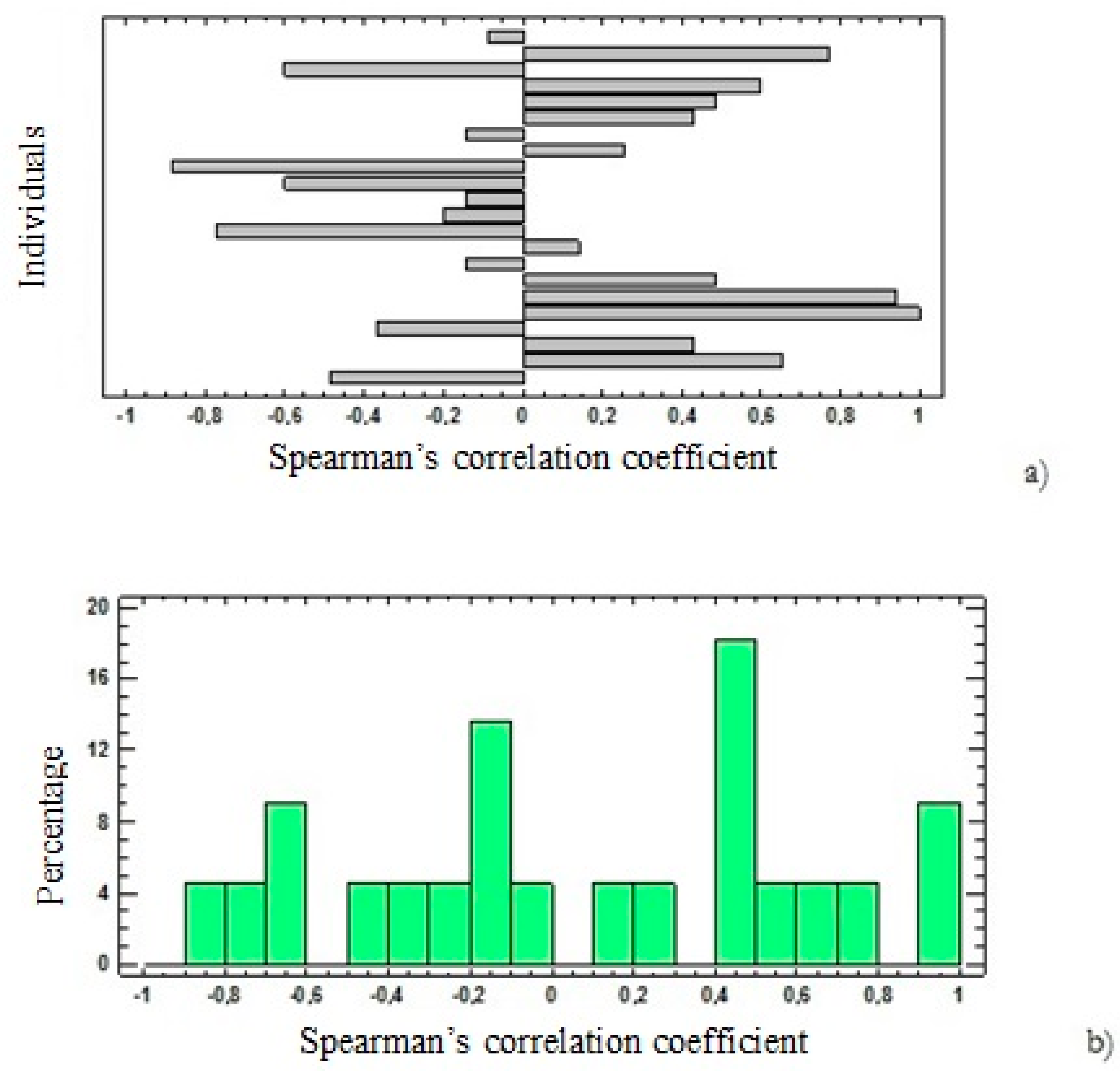
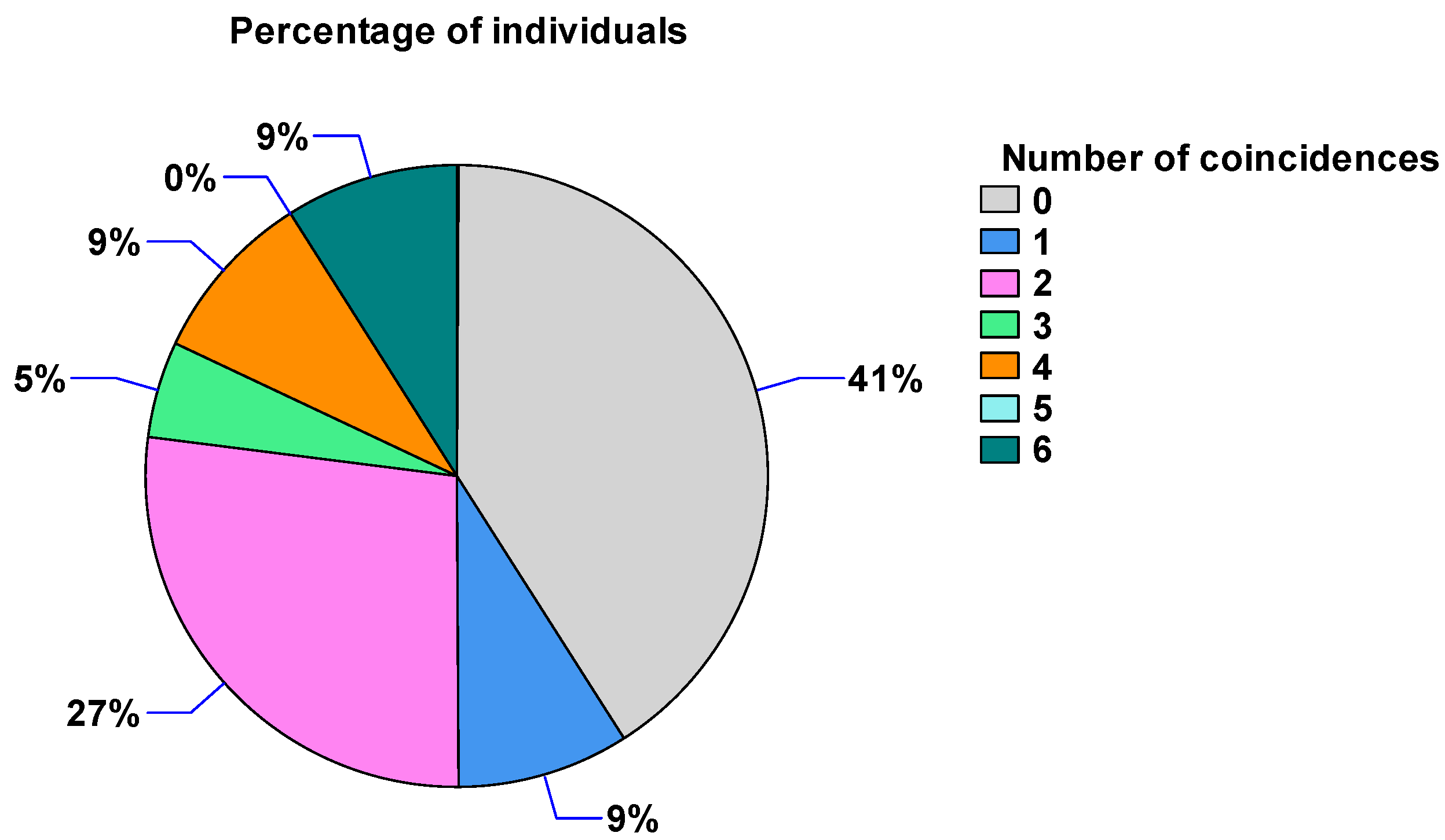
| Forest Attributes | ||
|---|---|---|
| Maximum | Minimum | |
| Density (tree/ha) | 850.0 | 75.6 |
| Basal area (m2/ha) | 40.7 | 6.6 |
| Mean height (m) | 14.7 | 8.7 |
| Alternatives | A | B | C | D | E | F |
|---|---|---|---|---|---|---|
| Distance to IP | 1.16% | 23.77% | 43.46% | 60.91% | 62.87% | 89.11% |
| UTM-X coordinate | 409,016.5 | 408,716.5 | 409,096.5 | 409,116.5 | 408,316.5 | 408,616.5 |
| UTM-Y coordinate | 4,512,872.5 | 4,512,272.5 | 4,512,552.5 | 4,512,732.5 | 4,512,312.5 | 4,512,732.5 |
| Type of Preference Relation in Alphabetical Order | Mathematical Properties Required |
|---|---|
| Biorder | Strong Intervality |
| Interval order | Irreflexivity, Strong intervality |
| Linear order | Asymetric; Negatively transitive; Complete |
| Partial order | Irreflexivity; Transitivity |
| Semiorder | Irreflexivity; Semitransitivity; Strong intervality |
| Weak order | Irreflexivity; Negatively transitive; Transitivity |
| Alternative 1 | Alternative 2 | Which Alternative Do You Consider More Sustainable? | ||
|---|---|---|---|---|
| Alternative 1 | Alternative 2 | Equal | ||
| B | A | |||
| B | E | |||
| C | A | |||
| B | C | |||
| E | A | |||
| E | F | |||
| C | D | |||
| F | D | |||
| D | B | |||
| C | E | |||
| F | B | |||
| A | F | |||
| D | A | |||
| F | C | |||
| D | E | |||
| A | B | C | D | E | F | |||||||
|---|---|---|---|---|---|---|---|---|---|---|---|---|
| Order | UTBM | AHP | UTBM | AHP | UTBM | AHP | UTBM | AHP | UTBM | AHP | UTBM | AHP |
| 1 | 4 | 8 | 5 | 4 | 6 | 4 | 6 | 1 | 1 | 2 | 0 | 3 |
| 2 | 8 | 4 | 5 | 9 | 3 | 1 | 3 | 4 | 1 | 2 | 2 | 2 |
| 3 | 2 | 4 | 5 | 2 | 1 | 7 | 3 | 5 | 4 | 0 | 7 | 4 |
| 4 | 1 | 2 | 3 | 1 | 6 | 4 | 6 | 8 | 2 | 3 | 4 | 4 |
| 5 | 6 | 1 | 3 | 3 | 2 | 4 | 4 | 3 | 4 | 8 | 3 | 3 |
| 6 | 1 | 3 | 1 | 3 | 4 | 2 | 0 | 1 | 10 | 7 | 6 | 6 |
| Alternative Order | A | B | C | D | E | F | Percent. of Coincidences |
|---|---|---|---|---|---|---|---|
| 1 | 4 | 4 | 4 | 1 | 1 | 0 | 63.6% |
| 2 | 4 | 5 | 1 | 3 | 1 | 2 | 72.7% |
| 3 | 2 | 2 | 1 | 3 | 0 | 4 | 54.5% |
| 4 | 1 | 1 | 4 | 6 | 2 | 4 | 81.8% |
| 5 | 1 | 3 | 2 | 3 | 4 | 3 | 72.7% |
| 6 | 1 | 1 | 2 | 0 | 7 | 6 | 77% |
© 2018 by the authors. Licensee MDPI, Basel, Switzerland. This article is an open access article distributed under the terms and conditions of the Creative Commons Attribution (CC BY) license (http://creativecommons.org/licenses/by/4.0/).
Share and Cite
Martín-Fernández, S.; Gómez-Serrano, A.; Martínez-Falero, E.; Pascual, C. Comparison of AHP and a Utility-Based Theory Method for Selected Vertical and Horizontal Forest Structure Indicators in the Sustainability Assessment of Forest Management in the Sierra de Guadarrama National Park, Madrid Region. Sustainability 2018, 10, 4101. https://doi.org/10.3390/su10114101
Martín-Fernández S, Gómez-Serrano A, Martínez-Falero E, Pascual C. Comparison of AHP and a Utility-Based Theory Method for Selected Vertical and Horizontal Forest Structure Indicators in the Sustainability Assessment of Forest Management in the Sierra de Guadarrama National Park, Madrid Region. Sustainability. 2018; 10(11):4101. https://doi.org/10.3390/su10114101
Chicago/Turabian StyleMartín-Fernández, Susana, Adrián Gómez-Serrano, Eugenio Martínez-Falero, and Cristina Pascual. 2018. "Comparison of AHP and a Utility-Based Theory Method for Selected Vertical and Horizontal Forest Structure Indicators in the Sustainability Assessment of Forest Management in the Sierra de Guadarrama National Park, Madrid Region" Sustainability 10, no. 11: 4101. https://doi.org/10.3390/su10114101
APA StyleMartín-Fernández, S., Gómez-Serrano, A., Martínez-Falero, E., & Pascual, C. (2018). Comparison of AHP and a Utility-Based Theory Method for Selected Vertical and Horizontal Forest Structure Indicators in the Sustainability Assessment of Forest Management in the Sierra de Guadarrama National Park, Madrid Region. Sustainability, 10(11), 4101. https://doi.org/10.3390/su10114101





